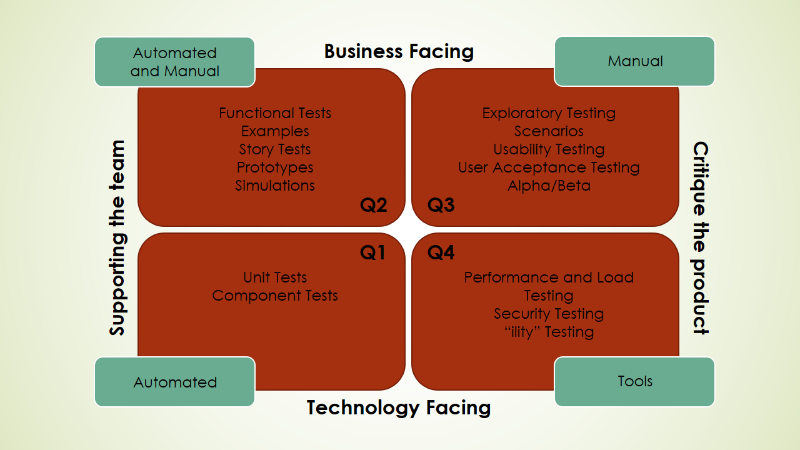testing
archive
Testing quadrants test levels and testing types
by Guru
Sun Mar 13 2016
WHAT ARE TESTING QUADRANTS ?**
Testing quadrants, defined by Brian Marick, align the test levels with the appropriate test types in the Agile methodology.
The testing quadrants model, helps to ensure that all important test types and test levels are included in the development lifecycle. This model also provides a way to differentiate and describe the types of tests to all stakeholders, including developers, testers, and business representatives.
In the testing quadrants, tests can be business (user) or technology (developer) facing. Some tests support the work done by the Agile team and confirm software behaviour. Other tests can verify the product. Tests can be fully manual, fully automated, a combination of manual and automated, or manual but supported by tools.
The four quadrants are as follows

The quadrants are not in any specific order. Also there are no hard and fast rules about what goes in what quadrant. Teams think through them as they do the release and iteration planning, so the whole team starts out by thinking about testing.
WHAT DOES EACH QUADRANT MEAN
The quadrants largely help the agile team to plan their testing for a project and make sure they have all the resources they need to accomplish it successfully .
Q1 - Quadrant1 is a developer lead effort and it is technology facing, the effort applied in this quadrant helps to support the scrum team. This involves getting complete structural or conditional unit test coverage, plus, component testing coverage as well. This helps to make sure that, are we building the product right? NOTE : with out this quadrant every other quadrant is not that effective and gets harder.
Q2 - Quadrant2 Business-facing tests that supports the scrum team as well. This involves capturing business examples and collaborating with customers to get more clarity in asserting the functionality, story testing, API testing, UI based testing using automated tools like selenium. This helps to make sure that, are we building the right product?
Q3 - Quadrant3 This involves recreating actual user experience and have scenario which are realistic. This relates to regular sprint demos or Informal demos, involving the real users/Customer support teams and get early and quick feedback.
Q4 - Quadrant4 This is technology facing but involves use of tools to assist in understanding the behaviours. Memory management, Data migration, Recovery, Test environments etc, are covered under this quadrant and stories written for it. Popular 'ilities' testing like modifiability, usability, adaptability, reusability, security, reliability, availability etc must also be considered as well.
HOW TO USE IT IN AGILE ? Test planning is not an individual effort and must be acknowledged by the whole team at the release planning or iteration planning. At release planning the team must understand and agree to the high level test strategy which encompass Unit testing/TDD, ATDD, function/Non functional testing etc - considering all quadrants. Identify who should own or do the various type of testing and how best to accomplish it, shared responsibility and focus on collaboration is the essence of this step. The team gets to highlight the requirement for any special skills or tools. At each iteration planning or execution, tests from any quadrant can be created as story and performed.
No story can be considered as done until testing is completed: Unit testing complete, automated regression tests successful run,customer requirements has been confirmed to be captured. Doneness in all quadrants achieved !